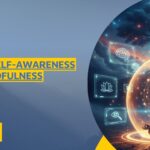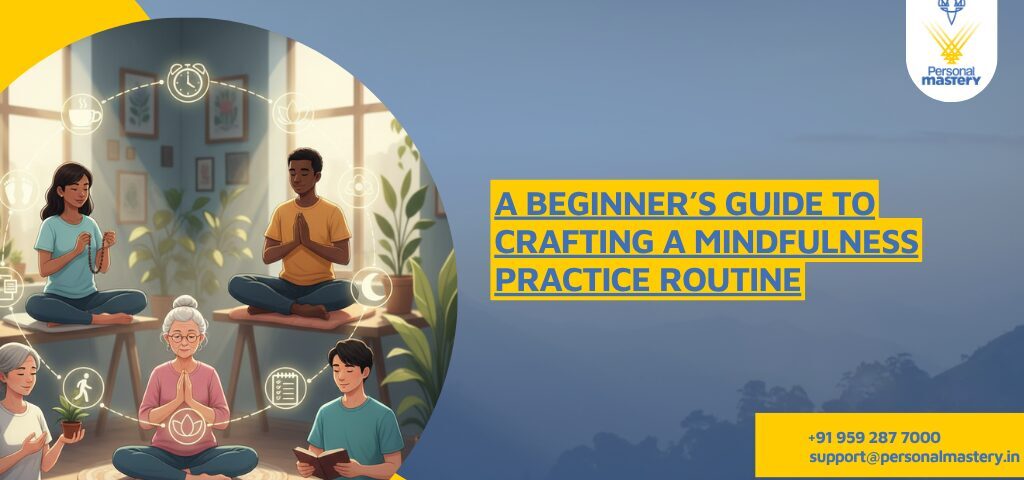
Developing Self-Awareness Through Mindfulness Techniques
November 10, 2025
No Formal leadership training To Manage Teams Effectively
November 17, 2025The sun hasn't yet come up, and you are sitting at your desk with a to-do list that appears more like a chaotic grocery list than anything else needing your attention. Emails continue to pour in, the phone keeps on vibrating, and you can nearly feel your shoulders being pulled tighter, like guitar strings. You take a drink of your coffee, considering that it would be a more powerful way to wake up, but instead, your thoughts only speed up.
Now, just imagine this — your day starts with a few deep breaths. You have a clear mind, calm thoughts, and even when your phone buzzes, you just smile because you know the right way to reply — not react.
Feels like a fantasy? No, it isn’t. The development of a personal mindfulness practice routine— that not only fits your daily life, but also cultivates your leadership traits, and associates your inner peace with outer clarity— is what makes this dream scenario become a reality.
Most importantly? You are not required to be like a monk or stay in a cross-legged position for hours and hours. What you need is merely a guide... and indeed this blog is that guide.
Step 1: Understand What Mindfulness Really Is (It’s Not What You Think!)
Let’s clarify this point — mindfulness is not “emptying the mind.” (If that were the case, Mondays would not be a part of the week.)
Mindfulness means being the artist of the moment — recognizing what is going on now without any form of judgment. If done deliberately, it carries on to transform your internal realm and your way of leading others.
That is the point where the Mindfulness Master Practitioner Training programs become very valuable. These workshops do not merely show you the breathing exercises; rather, they assist your mind's leadership circuitry to be attentive, understanding, and stout-hearted — all this even when the situation is very tense.
A combination of mindfulness and the use of very mild hypnosis makes it possible for you to be in control of your subconscious habits, and thus, instead of overthinking, you will have clarity and, instead of being anxious, you will have awareness.
Step 2: Start Small — Like, “Two-Minutes Small”
You don’t build mindfulness overnight — it’s not like ordering enlightenment on Amazon Prime.
Start with two minutes of stillness each morning. Sit, breathe, and simply notice your thoughts passing by like clouds.
Here’s the trick — consistency beats intensity. It’s far better to practice for two minutes every day than twenty minutes once a week.
If you need structured guidance, consider joining an Online Meditation Facilitator Course. These courses give you real-time techniques and interactive sessions that teach you how to integrate mindfulness into your workday — whether it’s during your morning coffee or before your next team meeting.
And yes, you can even practice mindfulness while brushing your teeth — just… don’t forget to rinse.
Step 3: Add the Hypnosis Element — Unlocking the Subconscious Leader
Here’s where things get fascinating.
Hypnosis isn’t about someone swinging a watch in front of your face. It’s about gently accessing the deeper layers of your mind — where your beliefs, fears, and habits live rent-free.
When combined with mindfulness, hypnosis allows you to reshape your inner dialogue. Instead of thinking,
“I can’t handle this pressure,”
you begin to think,
“I can breathe through this moment.”
Through methods taught in the IBPCT Accredited Mindfulness Course, leaders learn how to harmonize their conscious focus with subconscious transformation. It’s like upgrading your mental software without rebooting your personality.
Step 4: Integrate Mindfulness into Leadership Moments
Incorporating the mindset into the leadership process is the most effective way to go about it.
Picture a scenario where the entire team is under pressure, shouting at each other and the atmosphere is charged with tension when you enter the conference room. Rather than getting involved in that turmoil, you manage to stay calm — by taking a deep breath and focusing on the fact that you’re centered. The next moment, your composed demeanor has already affected the whole group.
That’s the performance of a mindful leader.
You can understand what being mindful is, if you ever participated in the Live Mindfulness Meditation Classes. Mindfulness is not a practice but rather a change of state. It gradually transforms you in different aspects such as tone, the ability to make decisions, and your influence as a leader.
Mindful leaders do not act on their impulses but they rather choose wisely the appropriate responses. No spell is being cast — it’s just daily application of the science of the brain.
Step 5: Design Your Personal Mindfulness Routine
Let’s make this practical.
Here’s a simple routine to kickstart your Mindfulness Course for Personal Growth:
Morning:
- 5 minutes of deep breathing before checking your phone.
- Visualize your day — see yourself responding calmly, not rushing.
Midday:
- Take a mindful lunch break. Eat slowly, taste every bite, and watch how your focus resets.
Evening:
- Reflect for 10 minutes: What went well today? Where did you lose focus? How can you do better tomorrow?
Bonus Tip: Use hypnosis-based affirmations. Repeat phrases like:
“Every breath I take grounds me in calm confidence.”
“I lead with presence, not pressure.”
Within weeks, you’ll notice subtle changes — you’ll talk slower, listen deeper, and think sharper.
Step 6: Train to Teach Mindfulness (Because Leaders Create Leaders)
When you begin to reap the benefits of mindfulness, sharing it is a very human reaction. This is how real leadership operates — it makes the benefit of the practice spread wider.
And here is where Personal Mastery’s Mindfulness Master Practitioner Training and the Online Meditation Facilitator Course come into the picture.
These courses are meant to enable you to become a certified mindfulness coach who can take, for instance, whole organizations, teams, or individuals along the path of emotional resilience and clarity.
Moreover, it’s not only about personal development since it’s IBPCT-accredited, but it also brings professional recognition.
You will acquire the skill to apply hypnosis as a teaching aid—not to manipulate minds, but to lead others through the process of achieving deeper self-knowledge and emotional mastery.
Step 7: The Ripple Effect — From Inner Calm to Organizational Clarity
Here’s the truth: when a leader practices mindfulness, the entire organization feels it.
A mindful leader listens better, communicates clearly, and makes decisions with empathy — not ego.
And guess what? People follow calm energy. They feel safe around leaders who don’t lose their cool. That’s what makes mindfulness not just a personal tool, but a strategic leadership advantage.
Leaders trained through programs like the IBPCT Accredited Mindfulness Course or Live Mindfulness Meditation Classes learn to cultivate these exact traits — presence, patience, and purpose.
It’s not about slowing down progress. It’s about moving forward with direction, clarity, and inner alignment.
Step 8: Keep It Light — Because Mindfulness Isn’t Meant to Be Heavy
Mindfulness should not be construed as a way of life that requires you to be dead serious all the time. Actually, it is the other way around. You acquire the ability to be unbothered, to be able to smirk on your mistakes, and to inhale and exhale through the turmoil.
(If ever you find yourself to be annoyed during meditation, give yourself a pat on the back — that’s mindfulness at work!)
Thus, mindfulness should not be seen as an additional chore. Instead, allow it to be your place of relaxation, contemplation, and amusement at the ridiculousness of life.
Final Thoughts: Your Mindfulness Journey Begins Now
In the present-day society, the concept of leadership has changed and is no longer about power but rather it is a matter of being aware.
The practice of mindfulness along with the methods of hypnosis brings to light a type of leadership that is marked by confidence, purity of thought, and even-treated choices.
Whenever you make your first conscious breath, the change will start, no matter if you choose the Mindfulness Master Practitioner Training, the Online Meditation Facilitator Course, or simply set up for yourself a daily mindfulness practice.
Hence, do not wait any longer, close your eyes, and take that breath... then step up to the place of leading with awareness.
Quote for the Blog:
“The best way to capture moments is to pay attention. This is how we cultivate mindfulness.” — Jon Kabat-Zinn
Contact Us
Phone: +91-9592877000
Email ID: support@personalmastery.in
Address: #748, Sector 9, Panchkula (Chandigarh), Haryana (INDIA) – 134113


